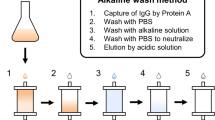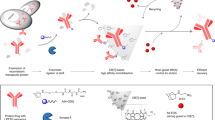Abstract
Plasmid DNA used for nonviral therapeutic gene transfer or nucleic acid vaccination has to be highly purified, devoid of contaminating components such as bacterial proteins, endotoxins, or bacterial chromosomal DNA. We have developed a new affinity chromatography technique for plasmid DNA purification: triple-helix affinity chromatography (THAC). This technique is based on the sequence-specific interaction of an oligonucleotide forming a triple-helix with plasmid DNA. The oligonucleotide was covalently linked to a chromatographic matrix, thus providing a reusable affinity support. By inserting a suitable homopurine sequence in the plasmid DNA, it is possible to obtain a triple-helix interaction that will only be stable at mild acidic pH and that will dissociate in alkaline conditions. A crude lysate from a recombinant E. coli, or a pre-purified plasmid DNA, is thus applied at acidic pH on to a THAC column. After extensive washing of the column, purified plasmid DNA is eluted using an alkaline buffer. The binding conditions of the plasmid DNA on to the column have been optimized, as well as the hybridization sequence and the linker group between the matrix and the third strand oligonucleotide. The THAC technique makes it possible to purify in one step supercoiled plasmid DNA, and to significantly reduce the level of contaminating RNA, endotoxins and chromosomal DNA. In particular, a 100-fold reduction of chromosomal DNA contamination over that obtained with conventional techniques can be achieved through a single additional THAC step. Further improvements of THAC technology are possible, and we anticipate that this technique can be scaled up for integration into a full commercial-scale DNA production process.
This is a preview of subscription content, access via your institution
Access options
Subscribe to this journal
Receive 12 print issues and online access
$259.00 per year
only $21.58 per issue
Buy this article
- Purchase on Springer Link
- Instant access to full article PDF
Prices may be subject to local taxes which are calculated during checkout
Similar content being viewed by others
Author information
Authors and Affiliations
Rights and permissions
About this article
Cite this article
Wils, P., Escriou, V., Warnery, A. et al. Efficient purification of plasmid DNA for gene transfer using triple-helix affinity chromatography. Gene Ther 4, 323–330 (1997). https://doi.org/10.1038/sj.gt.3300388
Received:
Accepted:
Issue Date:
DOI: https://doi.org/10.1038/sj.gt.3300388
Keywords
This article is cited by
-
Increasing the minicircle DNA purity using an enhanced triplex DNA technology to eliminate DNA contaminants
Molecular Therapy - Methods & Clinical Development (2015)
-
Separation of supercoiled from open circular forms of plasmid DNA, and biological activity detection
Cytotechnology (2011)
-
Quantitative analysis of specific target DNA oligomers using a DNA-immobilized packed-column system
Analytical and Bioanalytical Chemistry (2011)
-
Affinity purification of plasmid DNA by temperature-triggered precipitation
Nature Protocols (2007)
-
Base sequence- and T m-dependent DNA oligomer separation by open tubular capillary columns carrying complementary DNA oligomers as probes
Analytical and Bioanalytical Chemistry (2007)



